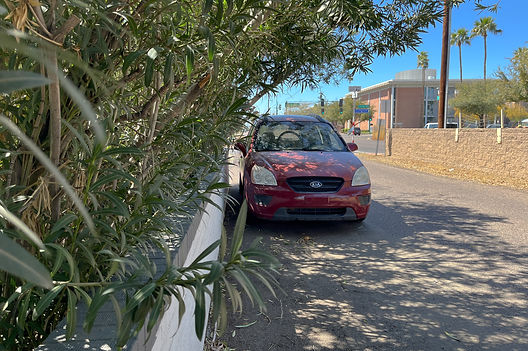Tree equity plans seek to bring shade to NAtion's hottest metropolis
The benefits — and challenges — of such a program are numerous
By Carsten Oyer

Trees and foliage lining a sidewalk along Thomas Road near 11th Avenue on March 19.
PHOENIX — City officials are planting trees, especially in low-income and vulnerable communities, to alleviate the effects of high temperatures.
Phoenix’s Office of Heat Response and Mitigation, alongside local nonprofits, sees shade as a crucial tool for reducing the environmental and economic consequences of heat. Tree equity, a program which prioritizes planting trees in areas that face historical injustices, allows the city to expand the shade canopy.

An alley perpendicular to Thomas Road near 7th Avenue on March 19.
Kayla Killoren, the city’s tree equity project coordinator, called the policy a “gamechanger” for underprivileged communities.
“The difference between being under shade canopy and outside of a shade canopy can be upwards of 30 degrees,” Killoren said. “That’s a lot, especially in the summer.”
Jhenifer Shipe, the president and CEO of local nonprofit Keep Phoenix Beautiful, echoed Killoren’s point.
“We know it’s really hot here,” Shipe said. “We certainly are always looking at opportunities to create comfort and coolness.”
Trees provide property owners with many benefits, Killoren said. Beyond the coolness the shade offers, trees can bring utility savings, improved health outcomes, infrastructure longevity, cleaner air and less stormwater runoff.
For example, the average small Phoenix house could use over $500 fewer kilowatt hours of energy with a correctly planted tree according to data from the Arizona Public Service Energy Estimator and the U.S. Department of Energy. That could reduce the impact of rising energy prices based on Federal Reserve Economic Data.
Photo: A tree in the Willo Historic District along Encanto Boulevard near 3rd Avenue on March 22.
Phoenix’s 2024 tree and shade master plan puts forward a goal to plant more than 27,000 new trees in the city by 2029, with half of the total investment in low-to-moderate-income communities.
Killoren said the Community Canopy Grant program received $2.5 million from the Inflation Reduction Act, which is helping to fund tree equity through early 2029. That federal funding requires that only certain income-based areas, such as south Phoenix, Maryvale, Sunnyslope and Alhambra, receive eligibility.
Despite the continued funding, planting more trees isn’t necessarily easy.
Killoren said that while many municipalities focus on school or park tree plantings, Phoenix must plant on private property. That process can be more difficult.
“Most of the land in the city of Phoenix is private property,” Killoren said. “If we want to achieve tree equity, we have to prioritize those areas.”
Killoren said many residents can find it difficult to actually plant the trees once they receive them. They may need to take time off work or find childcare, and transporting and physically planting the trees can be inaccessible for some.
Residents may also find the program to be “too good to be true,” Killoren said, and historically disadvantaged communities can have pre-existing distrust of city officials.
Nevertheless, Killoren said the program has addressed those issues.
“We’re able to go out to the individual level and offer these programs and make it as low-barrier as possible,” Killoren said.
The city not only gives away the trees but also provides contractors to plant them, equipment to take care of them and educational resources on maintaining them, Killoren said.
That’s particularly relevant given the estimated tree-related expenses from the city’s master plan. Simply purchasing and planting a 24-inch box tree costs roughly $1,050, and there’s an additional $100 estimated in annual maintenance.
By covering the price of the tree, labor and much of the irrigation, Killoren said the city can reduce the obstacles to expanding shade.
Killoren added that by hiring contractors, Phoenix reduces the barriers property owners face in physically putting the trees in the ground.

A dry sapling along the sidewalk of Thomas Road near 11th Avenue on March 19.
As for gaining the trust of residents, Killoren said that collaboration can bridge gaps between the city and its citizens.

Foliage providing shade for a car parked on a frontage road of Thomas Road near 11th Avenue on March 19.
“We’ve had to build a lot of trust, and a really great way of doing that is to incorporate our community-based organizations and community nonprofits that already have that established trust,” Killoren said.
Keep Phoenix Beautiful is one of those organizations; Shipe said it has partnered with the city government since it was founded 43 years ago.
Shipe added that Keep Phoenix Beautiful provides a balance to the city’s focus on low-income areas. The organization seeks to serve parts of the city that may not qualify for the Community Canopy Grants.
“We can find a lot of the balance to ensure that we’re planting trees where there’s the need,
the interest and the opportunity to keep the trees healthy and sustainable,” Shipe said.
For Killoren, the idea of trust extends beyond the trees, particularly in communities that may have reason to lack it.
“It goes far to know that the city of Phoenix has developed this program, and that the city of Phoenix cares about these issues,” Killoren said. “It helps to build rapport and to establish that trust again.”

Trees in a neighborhood along 11th Avenue south of Thomas Road on March 19.